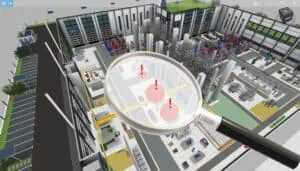You are probably familiar with this situation: You have invested many hours in your project presentation slides. Your idea for a solution is mature. Now you are sitting in a deadlocked meeting and after endless discussion the decision is postponed.

As is often the case, how well a proposed solution is received by your audience depends to a large extent on communication. Because communication problems slow down many industrial projects. A lack of transparency can be a major cause. Be transparent and you are understood. If you are understood you are accepted by your audience. Practitioners and authors in communication theory call this connection the basic law of communication:
True is not what A says. True is what B understands.
But how do you understand the complex issues and considerations that shape projects in factory planning? We want to show 5 ideas that will help you to give your work the recognition you need. For example in project presentations, meetings or workshops.
Idea 1: Use previously unused data
Data is content and is the raw material of our digital age. It is only through the analysis and linking of data that these raw materials become information and a knowledge advantage for yourself, the team and the company. So look for previously unused data or create new relationships between contents. Possible data sources are existing IT systems (ERP, PPS, MES, logistics control center, etc.), work plans or CAD plans. Sometimes the data is also slumbering outside the company, e.g. the building floor plan for the architect.
So unlock that untapped data and make it meaningful content to your work to support your project presentation.
Practical tip: Linking the CAD floor plan and processes (material flow data) creates completely new communication options within your project presentation. You determine the data by tracking transports through a material flow analysis.
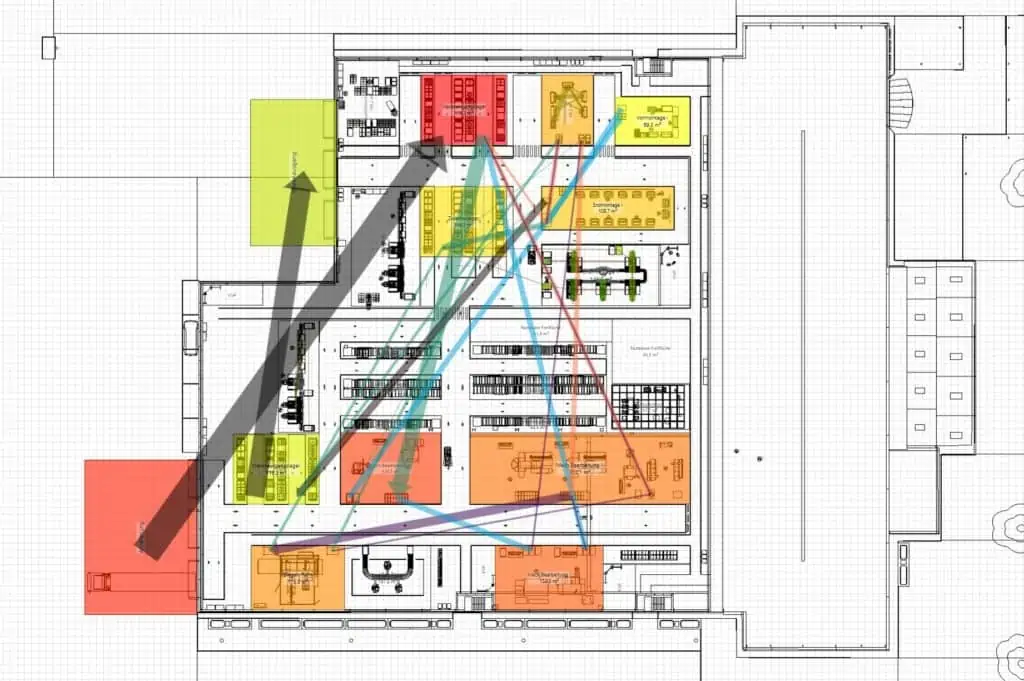
This illustrates not only material flow intensities, but also the distances they have to cover. You create a transparent presentation of the material routings and the associated transport effort for your audience. With this key figure, you can find answers to the question of the “right” arrangement of manufacturing, assembly, logistics or storage areas in the factory. This is crucial information to move forward in a planning project. It also creates a fundamental understanding in presentations with your audience or team members. This can be PowerPoint slides or even the presentation directly in a software.
Idea 2: Don’t trust your intuition only
First of all, the concept of intuition is not about higher inspiration or the seventh sense. Rather, it is about a human sense that is commonly referred to as gut feeling. This consists largely of experience, acquired specialist knowledge, creativity and imagination. All helpful characteristics with which you can develop successful solutions to the given planning tasks and which your employer would like you to have.
The gut feeling can also meet you as a challenger. Namely when it is not your own. In a project meeting it quickly becomes clear that intuition is difficult to compare or argue with. And decision-makers in particular usually rely on key figures and proven data in a presentation.
Make yourself aware of this and acquire additional objective information for your planning solution. Integrate it in your PowerPoint presentation or in the planned course or your slides. In the project presentation you can then react safely to any questions and explain in black and white why you have chosen this solution.
Suggestions for objective KPIs
- Space requirement
- Investment costs for new equipment
- Conversion costs
- Logistics effort
- Lead time
So couldn’t you design the presentation completely on the basis of objective key figures?
No, because in industrial engineering in particular (fortunately) not all influencing variables can be fully recorded and described. This would also mean that human mind could be eliminated from decision-making processes.
Practical tip: Variant planning with benefit analysis
Variants arise almost inevitably during the planning process. They arise with authoritative decisions that drive the project in different directions (e.g., manual assembly vs. automation). Variants accomplish two practical things in a presentation:
- they convey to other participants the possible paths to the solution
- they promote the joy of decision-making by narrowing down the solution space in a meaningful way
With a subsequent cost-utility analysis, you put different key figures in relation and thus offer an evaluation for the different variants. In summary, this means for your presentation: Intuition is in the variants and the utility value analysis provides an objective view.
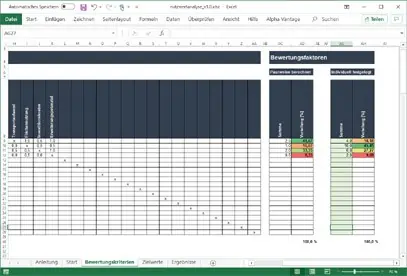
Idea 3: Get ready for decision-making processes
We want to inspire you to study the social and psychological foundations of communication. Make yourself aware that these skills (so-called social skills) are just as important as technical skills for the success of a project presentation.
A study by the management consultancy McKinsey has shown that 70 percent of change initiatives in companies do not achieve their goals, which is largely due to resistance from employees and the lack of support from management (decision-makers).
Link: https://www.mckinsey.com/featured-insights/leadership/changing-change-management
“The difficulty lies not so much in developing new ideas as in escaping from old ones.”
Economist John Maynard Keynes
Changes in production, assembly, logistics or storage areas within the factory are the subject of countless discussions in planning projects. Hardly anyone has no opinion on this. At latest in their own area, the pulse of many participants is rising. Different perspectives and conflicting goals shape the picture. Communication is a key success factor. This applies not only to communication in planning teams, but also to the presentation of solutions to those affected.
So what does good communication look like in a project presentation?
- Make sure everyone involved understands the need for change. If there are no compelling reasons, it is difficult to drive change.
- Make potential visible and then make a joint decision for change. The need for action must be clear to everyone.
- Early participation in discussion and planning reinforces the sense of a common idea. By having a common goal, collaboration succeeds, especially when problems arise.
- How the solution came about is often more important to outsiders than the solution itself. According to the motto: It’s not the destination, it’s the journey.
- Have a clear understanding of your company’s goals and values. This will help you to understand decision makers and align your own communication.
Idea 4: Use early 3D visualization
Especially at the beginning of a project, the effort for a 3D visualization does not seem justified. The classic approach is as follows: At the kick-off meeting for the project, the manager invites one of his investors, his architect, his planner (you) and the production manager. Everybody is motivated and excited about the manager’s idea to expand the factory.
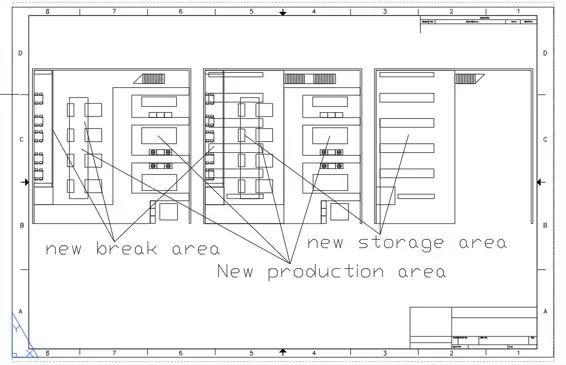
The manager presents the 2D-CAD drawing and tries to explain his thoughts. According to his ideas, the planned extension contains a new production area, a new storage area and a new break room. Unfortunately, the invitees can’t really interpret the CAD plan very well. This is because 2D drawings are highly abstracted compared to reality. In the end, everyone has understood the plan differently and leaves the meeting. In the worst case, people are now working in different directions. A lot of time is wasted and the project is delayed. Followed by frustration and demotivation.
The advantages of 3D visualization can be easily derived from this example. Planning in 3D leads to a significantly higher transparency for all parties involved and thus to a higher planning quality. Cultural, linguistic and technical barriers are irrelevant. The language of the 3D model is universal. Experience shows that if a 3D model is used early on in a project, it is much easier for everyone to develop a common understanding. There are fewer misunderstandings, it saves a lot of time and money and everyone stays motivated.
Certainly one of the easiest ways is to use 3D screenshots from a software in a PowerPoint or Google slide. However, as soon as a question like the following arises: “And what is there behind the cold store?” a static view or slide is no longer sufficient.
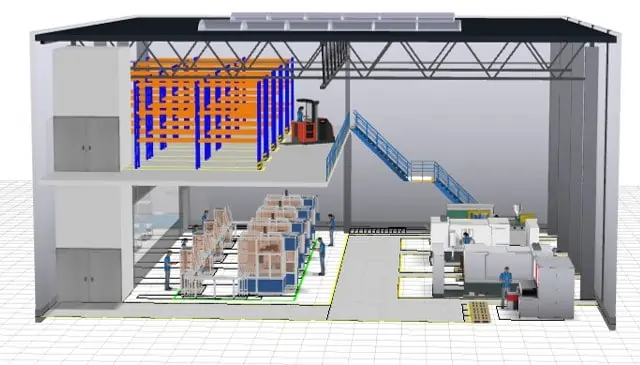
Interactive 3D visualization
Even though materialflow plays a very important role for factory planners, its modeling and interpretation is usually reserved for a circle of experts involved in a planning project and not for the entire audience. Use Immersion effects for communication across the board. This refers to the immersion of an observer in a virtual model. For example, a realistic 3D visualization alone can contribute enormously to the understanding of a planning status. Walking through a three-dimensional production hall on a large screen creates acceptance. Virtually walk-through 3D scenes are already expected as a minimum level of immersion.
The 3D visualization should be interactivly. Turning a container or moving a workbench makes the experience of the planning solution even more transparent. In addition, you can react on practical questions spontaneously in the project presentation:
“How do we actually get the new machine into the hall? Will it fit through gate 1 or do we have to enter through the large hall gate at the back? Then we may have to dismantle this and that before the move.”
Quickly lifting the machine by 20 cm and thus manipulating its relocation path with a finger, quickly setting a marker in the layout at critical points – this and similar examples show how interactive 3D visualization can make communication more effective during a project presentation.
Slides are fine and of course needed, but with an interactive 3D presentation, a dull presentation can turn into an interactive workshop with a lively exchange of ideas among participants. Your audience will thank you.
Idea 5: Check your tools – PowerPoint & Excel spreadsheet, the perfect tools for your project presentation? – No.
In most companies, investing in one or more tools is not a one-time decision. In most cases, the purchase evolves historically as the company grows. For example, many companies own multiple tools from different vendors.
General software such as PowerPoint or Excel are nearly ubiquitous. For example, a spreadsheet is ideal for collecting and summarizing data. However, when it comes to converting these spreadsheets into understandable graphics for a project presentation, one quickly reaches the limits. In addition, it becomes clear time and again that there are serious deficits with regard to simple and fast operation.

Modern software can do that better. Take a critical look at your toolbox. Learn how to find the right software for your tasks in this blog article:
Utility analysis for the selection of planning software
But also among the planning specialists there are specializations due to the complexity of the different planning tools. There are specialists in the field of simulation among production system planners, while others are specialists in the CAD field. Hardly any user is able to use all tools in the planning process using the technical possibilities (simulation, CAD, VR, …).
Modern software tools have solved this problem with a user-friendly design. They are easy and intuitive to use without the need for special and usually long and expensive training.
No problem, simply subscribe to our Blog-News!

